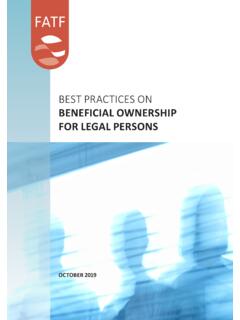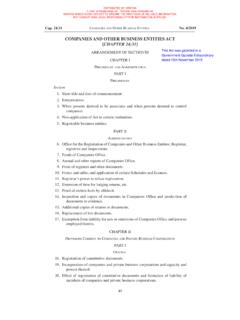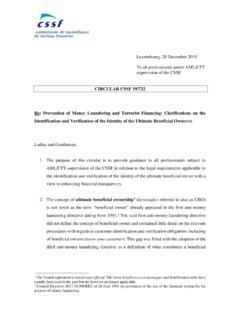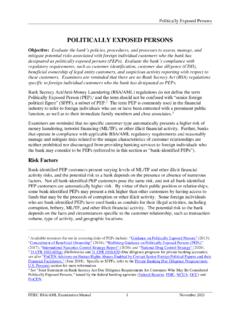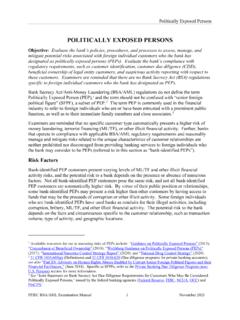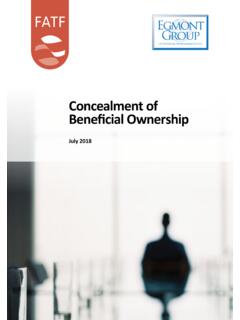Transcription of AML/CFT RISK BASED FRAMEWORK FOR BANKS 2019
1 AML/CFT RISK BASED FRAMEWORK FOR BANKS . 2019. AML/CFT Riske BASED FRAMEWORK for BANKS Contents Chapter 1: Overview of ML/TF 2. Introduction .. 2. Risk management and mitigation .. 3. Chapter 2: Risk Management FRAMEWORK , Process and 6. Risk Management 6. The risk management process .. 8. Risk identification .. 8. Risk assessment .. 11. Calculation of Risk Score .. 12. Risk Assessment and Management Exercise .. 15. Risk Treatment .. 16. Monitor and review .. 17. Chapter 3: Risk management and mitigation control measures .. 19. Risk Management Strategies .. 19. Ongoing Risk 20. Higher risk scenario .. 21. Lower risks Scenario .. 22. Documentation of the RBA process .. 25. pg. 1. Chapter 1: Overview of ML/TF Risk Introduction The risk- BASED approach (RBA) is central to the effective implementation of the FATF. Recommendations. The focus on risk is intended to ensure a bank is able to identify, assess and understand the ML/TF risks to which it is exposed to and take the necessary AML/CFT control measures to mitigate them.
2 The RBA serves as a useful means to understand the risk areas where related risks are relatively high in order to allocate resources in the most effective way. The RBA: (a) recognizes that the ML/TF threats to a bank vary across customers, geographic, products and services, transactions and distribution channels;. (b) allows the bank to apply procedures, systems and controls to manage and mitigate the ML/TF. risks identified; and (c) facilitates the bank to allocate its resources and internal structures to manage and mitigate the ML/TF risk identified. The RBA provides an assessment of the threats and vulnerabilities of the bank from being used as a conduit for ML/TF. By regularly assessing the bank's ML/TF risks, it allows the bank to protect and maintain the integrity of its business and the financial system as a whole. BANKS applying a risk- BASED approach need to be proactive in seeking out information about money-laundering trends and threats from external sources, such as law enforcement, as well as relying on their own experiences and observations.
3 This allows BANKS to effectively review and revise their use of AML tools to fit the specific risks that they face Accordingly, this FRAMEWORK is aimed at: i) Assisting the BANKS to design and implement AML/CFT control measures by providing a common understanding of what the RBA encompasses;. ii) Outlining the recommended steps involved in applying the RBA. In the event a bank has developed its own RBA, the adopted RBA must be able to achieve the outcomes intended under this FRAMEWORK ;. iii) Providing general information about risks related with the customers, products, services, delivery channels and geographical locations. pg. 2. Risk management and mitigation BANKS are required to have policies, controls and procedures that enable them to manage and mitigate effectively the risks that have been identified. They are required to monitor the implementation of those controls and to enhance them, if necessary. The policies, controls and procedures must be approved by the Board, and the measures taken to manage and mitigate the risks (whether higher or lower) should be consistent with AML/CFT Act and Rules and Regulations and other AML/CFT requirements.
4 What is risk? Risk can be defined as the combination of the probability of an event and its consequences. In simple term, risks can be seen as a combination of the chance that something may happen and the degree of damage or loss that may result if it does occur. What is risk management? Risk management is a systematic process of recognizing risk and developing methods to both minimize and manage the risk. This requires the development of a method to identify, prioritize, treat (deal with), control and monitor risk exposures. In risk management, a process is followed where the risks are assessed against the likelihood (chance) of them occurring and the severity or amount of loss or damage (impact) which may result if they do happen. Which risks do BANKS need to manage? For the ML&TF aspects, FID expects a risk management practice to address two main risks: business risk and regulatory risk. Business risk is the risk that your business may be used for ML&TF.
5 The BANKS must assess the following risks in particular: customer risks products or services risks business practices and/or delivery method risks country or jurisdictional risks. Regulatory risk is associated with not meeting all obligations of BANKS under the AML/CFT Act of Bhutan 2018, AML/CFT Rules and Regulation 2018 (including all amendments), the other relevant Rules issued under the Act and instructions issued by FID. Examples of regulatory obligations that may be breached includes reporting of STR, verifying the identity of your customer, and having an AML&CFT program (showing how a business identifies and manages the ML&TF risk it may face) etc. pg. 3. It is unrealistic that a bank would operate in a completely ML&TF risk-free environment. Therefore, it is suggested that a bank shall identify the ML&TF risk it faces, and then works out the best ways to reduce and manage that risk. BANKS will have flexibility to construct and tailor their risk management FRAMEWORK for the purpose of developing risk- BASED systems and controls and mitigation strategies in a manner that is most appropriate to their business structure (including financial resources and staff), their products and/or the services they provide.
6 Such risk- BASED systems and controls should be proportionate to the ML&TF risk(s) a bank reasonably faces. For effective risk management, BANKS should at all levels follow the principles below: 1) Risk management contributes to the demonstrable achievement of objectives and improvement of performance, governance and reputation. 2) Risk management is not a stand-alone activity that is separate from the main activities and processes of the bank. Risk management is part of the responsibilities of management and an integral part of all organizational processes, including strategic planning. 3) Risk management helps decision makers to make informed choices, prioritize actions and distinguish among alternative courses of action. 4) Risk management explicitly takes account of uncertainty, the nature of that uncertainty, and how it can be addressed. 5) A systematic, timely and structured approach to risk management contributes to efficiency and to consistent, comparable and reliable results.
7 6) Risk management is BASED on the best available information. 7) Risk management is aligned with the bank's external and internal context and risk profile. 8) Risk management is transparent and inclusive. 9) Risk management is dynamic, iterative and responsive to change. It must iteratively seek to collect and update data related to identified risks and to review mitigation plans accordingly. Following the above-mentioned principles, BANKS are expected to develop and maintain logical, comprehensive and systematic methods to address each of the components referred to in this FRAMEWORK and that such methods and the BANKS ' approach to ML&TF risk are understood, implemented and maintained, to some appropriate extent, within their organizations. BANKS would be expected to demonstrate to FID and DFRS (for example, when an inspection is being conducted) that their risk BASED systems and controls are suitable to their particular businesses and consistent with prudent and good practices.
8 In assessing and mitigating ML&TF. pg. 4. risk, the BANKS should consider a wide range of financial products and services, which are associated with different ML/TF risks. These include, but are not limited to: 1) Retail banking: where BANKS offer products and services directly to personal and business customers (including legal arrangements), such as current accounts, loans (including mortgages) and savings products;. 2) Corporate and investment banking: where BANKS provide corporate finance and corporate banking products and investment services to corporations, governments and institutions;. 3) Investment services: where BANKS provide products and services to manage their customers'. wealth (sometimes referred to as privileged or priority banking); and 4) Correspondent services: where banking services are provided by one bank (the correspondent bank ) to another bank (the respondent bank ). BANKS should be mindful of those differences when assessing and mitigating the ML/TF risk to which they are exposed.
9 Pg. 5. Chapter 2: Risk Management FRAMEWORK , Process and Calculation Risk Management FRAMEWORK Risk management FRAMEWORK is the process used to identify the potential threats to an organization and to define the policies and procedures to eliminate or minimize the threats, as well as developing a strategy or guideline to monitor and review of those identified risk. FRAMEWORK consists of: a) Establishing the internal and external context within which the designated service is, provided or to provide. These may include: i. the types of customers, ii. the nature, scale, diversity and complexity of their business, iii. their target markets, iv. the number of customers already identified as high risk, v. the jurisdictions the bank is exposed to, either through its own activities or the activities of customers, especially jurisdictions with having high level of deficiencies in AML/CFT . controls and listed by FATF, vi.
10 The distribution channels, including the extent to which the bank deals directly with the customer or the extent to which it relies on third parties to conduct CDD and the use of technology, vii. the internal audit and regulatory findings, and viii. the volume and size of its transactions, considering the usual activity of the bank and the profile of its customers. b) Risk identification, c) Risk assessment or evaluation, and d) Risk treatment (mitigating, managing, control, monitoring and periodic reviews). In identifying and assessing the ML/TF risk to which they are exposed, BANKS should consider a range of factors which may include: Figure 1: The risk management FRAMEWORK Risk identification Identify the main ML/TF risks: customers products & services business practices/delivery methods countries you do business with Identify the main regulatory risks pg. 6. Risk assessment/measurement Measure the size & importance of risk: likelihood chance of the risk happening impact the amount of loss or damage if the risk happened likelihood X impact = level of risk (risk score).
